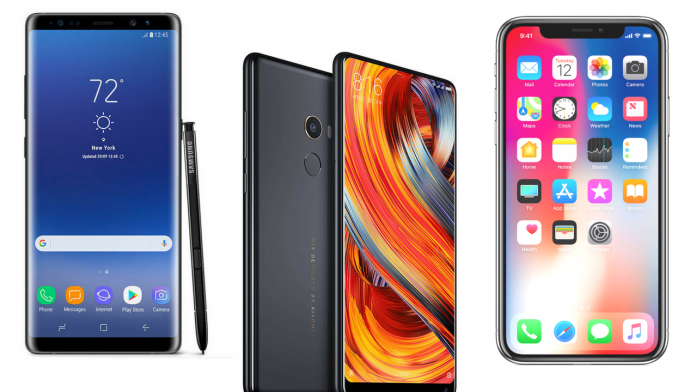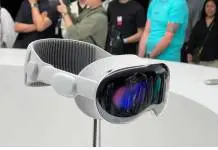
Apple revealed the iPhone X to the world on Tuesday, and with its announcement, it joined one of the latest trends of the smartphone industry: cutting the bezels out of the front panel and making it all about the display.
The 10th-anniversary edition of the iconic flagship carries the most expensive price tag of a consumer-oriented device in recent times but is closely followed by the recently launched Samsung Galaxy Note 8. Like its brothers of the main Galaxy lineup, the Note 8 also makes a significant effort to emphasize the screen.
A third and unlikely contender comes from Xiaomi: the Mi Mix 2, revealed on the eve of Apple’s annual event. The second gen Mi Mix does surprisingly well at bezel-less displays, capitalizing on that frontal real estate as much as it can. Here is how they all compare in all aspects.
iPhone X vs. Galaxy Note 8 vs. Mi Mix 2: Design
Out of all three phones, Samsung’s Galaxy Note 8 is the largest and sports the largest screen as well. At 6.3 inches, it topples the Mi Mix 2’s 5.9 inches and the iPhone X’s 5.8. That is all well, but who applies the concept better?
As unlikely as it is, many were surprised at how effective and cool Xiaomi’s approach was. The Mi Mix 2 only has a thin bottom bezel, which helps a lot at creating the illusion of a complete front panel that is all display.
Samsung’s top and bottom stripes only got thinner from the Samsung Galaxy S8’s attempt, and the iPhone X’s now infamous upper chin does not do it any favors. There is also a debate over what constitutes a truly full display: does it occupy (almost) the entire front like Apple or wraps around the edges like Samsung?
iPhone X vs. Galaxy Note 8 vs. Mi Mix 2: specs
Leaving first impressions aside, performance is also a hot topic when it comes to this sort of flashy devices. Apple comes out on top on this one, with its A11 Bionic chip with neural engine beating the competition in early benchmark tests.
Samsung’s Snapdragon 835 and Exynos 8895 are not too shabby, and Xiaomi packs the same Qualcomm chipset on the Mi Mix 2. New SoCs are soon debuting on upcoming flagships, so Apple can enjoy reigning supreme for a little while longer in terms of processing power.
However, the iPhone X has just 3 GB of RAM, while the Note 8 doubles that number and Xiaomi nearly triples it at 8 GB. Kind of overkill, people say, but most would agree that old iPhones could do better with an extra GB or two of RAM too (especially for their prices).
Other than that, all three phones support storage up to 256 GB and start at 64 GB. Xiaomi and Samsung run Android with their custom skins, while Apple runs iOS and will soon upgrade to iOS 11. Only the Note 8 will make the jump to Oreo.
iPhone X vs. Galaxy Note 8 vs. Mi Mix 2: features
Samsung and Apple are tied on the feature battle, with Xiaomi coming as a far behind runner-up. The Mi Mix 2 ticks all the right boxes, with HDR pictures, decent cameras, fingerprint sensor, and fast charging, but the two tech giants bring something extra.
The Galaxy Note 8 is dust and waterproof, supports Samsung Pay, has fingerprint and iris scanners, a dual 12 MP camera setup with OIS, 4K video, HDR, fast charging, and wireless charging with support for both Qi and PMA standards. It also supports both Bixby and Google Assistant and comes with an S Pen.
The iPhone X, meanwhile, has the same condition withstanding capabilities, Apple Pay with peer-to-peer wire transfers, 12 MP dual cameras with optical and digital zoom, 7 MP front camera with Portrait and Lighting mode, fast charging, Qi wireless charging, Siri, and Face ID for safe device unlocking.
According to this @TechCrunch photo, the iPhone X will cost one human life. pic.twitter.com/1NHMoGCucq
— Danny Sullivan (@dannysullivan) September 12, 2017
iPhone X vs. Galaxy Note 8 vs. Mi Mix 2: price
Xiaomi has the two tech giants beat when it comes to price since it is expected to go on sale later this September for approximately $500. It will only be available in China though, and a ceramic version is expected to launch as well for $720 roughly.
Even the most expensive edition of the Mi Mix 2 falls short of the starting price of the Samsung Galaxy Note 8, not to mention the iPhone X. The phablet straight out of South Korea starts at $929, while Apple’s anniversary flagship costs $999 at its lowest and tops at $1,150. Those are some expensive options.
Considering the fact that Xiaomi’s display is IPS LCD with 1080 x 2160 resolutions while Apple and Samsung both sport Super AMOLED screens with higher resolutions and protection, there is a somewhat logical explanation for the price tag.
Still, the Mi Mix 2 could cost half of what the iPhone X does if it launches in the U.S., and you wouldn’t have to tap videos or photos for them to adjust so the upper chin doesn’t interfere with your watching experience. It seems sometimes less is, indeed, more.
Source: Apple










